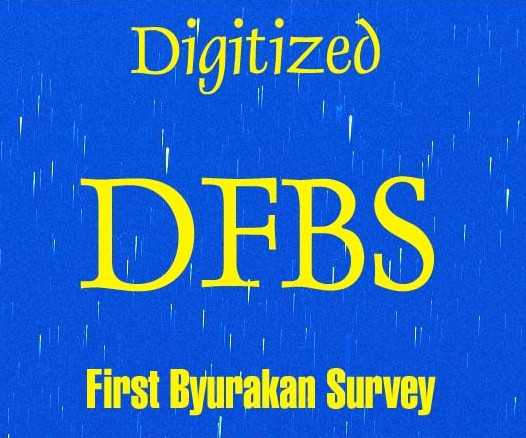FUTURE
SURVEYS BASED ON THE DFBS
WHAT IS STILL IN THE FBS PLATES
5350 interesting objects have been selected from
the FBS plates, including 300 AGN. There are 3 catalogs at CDS with
objects discovered using the FBS. Its observational material is still
useful. A number of new surveys may be undertaken using
the FBS spectra. And especially it will be efficient to use the digitized
FBS for any studies. The use of the
digitized spectra will increase the efficiency and homogeneity of object
selection. A few research projects are planned based on the DFBS
low-dispersion spectra, such as:
·
new bright QSOs (<18m).
One can expect some 200 new bright QSOs with m<16m from
FBS, and some 1000 fainter objects, and it will be the most complete
sample for study of their local density;
·
new Markarian (UVX) galaxies.
The eye selection has missed objects near the limits of the plates. It
will be particularly useful to study their population at higher
redshifts;
·
new blue stellar objects. The
2nd part of the FBS will be continued for the whole area and a total
number of some 4500 objects is expected (new
WDs, sds, CVs, PNN, etc.);
·
new blue compact dwarf galaxies.
22 Markarian galaxies and 135 SBS galaxies are candidate BCDGs. BCDGs are
important for understanding the early stages of galaxy evolution, and
they are crucial targets for SST because they represent the primordial
stages of galaxy formation.
·
optical counterparts of IR,
radio, X-ray and other sources (optical identifications). The use of the
DFBS will allow continue the program of IRAS identifications to other
regions of the FBS with a comparison with 2MASS data and their future
study with SST, as well as identify radio and X-ray sources;
·
late-type stars (M, S, carbon
stars). For automatic selection it will be easier to separate real
spectra from artifacts having the modeled templates beforehand;
·
planetary nebulae; to locate all
PN in the Galaxy, particularly at high galactic latitudes;
·
all emission line stars
(cataclysmic variables, etc). 1D spectral cuts and computer analysis will
greatly improve discovery of such objects;
·
non-UVX white dwarfs. There are
a lot of WDs without UVX. Many such objects have been located during the
Second part of the FBS. They will complement the sample of high-latitude
WDs for further studies on stellar evolution and evolution of the Galactic
halo;
·
studies of star clusters and
clusters of galaxies. It is useful to study clusters using homogeneous
observational material, especially having low-dispersion spectra of all
the objects.
DFBS provides an earlier time epoch for
comparison with other all-sky surveys (such as SDSS), which are now
underway, opening a new window in the time domain. For example, changes
in brightness and optical spectra on the time scale of decades can be
studied.
|
